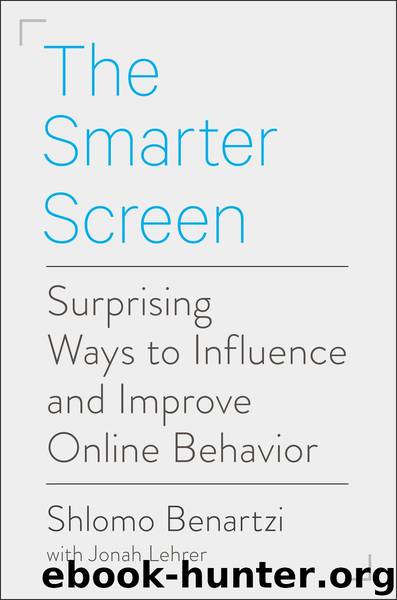The Smarter Screen by Shlomo Benartzi

Author:Shlomo Benartzi
Language: eng
Format: epub
Publisher: Penguin Publishing Group
Published: 2015-09-16T16:00:00+00:00
THE UPSIDE OF HARD
Why does disfluency lead to more learning? Oppenheimer refers to the ugly fonts as a “desirable difficulty,” noting that multiple studies have shown that increasing disfluency leads subjects to process information more carefully. Instead of just reading the text, they are forced to think about it. The speedy mind—and remember that people might think even faster on screens—is made to slow down. As a result, people engage with the material at a deeper level.
Consider a series of recent experiments led by Adam Alter, a psychologist at NYU. In his research, Alter relied on a well-known assessment called the Cognitive Reflection Test, or CRT, pioneered by the psychologist Shane Frederick.11 The short test is designed to measure the extent to which an individual relies on mental shortcuts and quick instincts, giving subjects tricky questions in which their initial hunch is almost always incorrect. Here’s a classic question from the CRT: “A bat and ball cost $1.10 in total. The bat costs $1 more than the ball. How much does the ball cost?” The intuitive response is that the ball costs ten cents. That, however, is incorrect: the ball actually costs five cents. (The bat costs $1.05, for a total of $1.10.) When Alter gave people the CRT in a disfluent font—he used a small print in a very light gray—they were far less likely to get the wrong answer.12 While 90 percent of subjects in the fluent condition got at least one of the CRT questions wrong, only 35 percent did so in the disfluent group. In short, the hard-to-read text forced subjects to think more deeply about the questions, which led them to get far higher scores.
It’s worth pointing out, however, that not every study looking at disfluent fonts gets similar results. For reasons that remain unclear, many experiments have found little to no effect when counterintuitive math problems, such as those in the CRT, are printed in hard-to-read letters. While people take longer to answer the questions, this extra time doesn’t lead to higher scores. Clearly, more research is needed.13
In a separate experiment, Alter and colleagues made up a user review of a new MP3 player. When the headline of the review was printed in an easy-to-read font, subjects tended to focus on superficial aspects, such as the look of the reviewer. However, when the headline was printed in a disfluent font people were far more likely to make a judgment based on the substantive content of the review.14 The takeaway, says Alter, is that exposing people to disfluent information increases the likelihood that they will engage in more deliberate thinking strategies. “When something is difficult, that should act as a meta-cognitive alarm or a signal that you don’t understand it as well as you perhaps should,” Alter said in a 2013 interview.15 The feeling of disfluency, then, isn’t just an annoyance or inconvenience—it’s actually a crucial mental signal, telling us to slow down and focus. It’s a reminder that we need to think more.
Such a signal has enormous practical application.
Download
This site does not store any files on its server. We only index and link to content provided by other sites. Please contact the content providers to delete copyright contents if any and email us, we'll remove relevant links or contents immediately.
| Advertising | Consumer Behavior |
| Customer Service | Marketing |
| Public Relations | Sales & Selling |
| Search Engine Optimization |
Influence: The Psychology of Persuasion by Robert B. Cialdini(4217)
The Miracle Morning by Hal Elrod(3959)
The Hacking of the American Mind by Robert H. Lustig(3621)
Pre-Suasion: A Revolutionary Way to Influence and Persuade by Robert Cialdini(3475)
Unlabel: Selling You Without Selling Out by Marc Ecko(3022)
Hidden Persuasion: 33 psychological influence techniques in advertising by Marc Andrews & Matthijs van Leeuwen & Rick van Baaren(2832)
Who Can You Trust? by Rachel Botsman(2750)
Kick Ass in College: Highest Rated "How to Study in College" Book | 77 Ninja Study Skills Tips and Career Strategies | Motivational for College Students: A Guerrilla Guide to College Success by Fox Gunnar(2737)
Ogilvy on Advertising by David Ogilvy(2736)
Purple Cow by Seth Godin(2730)
I Live in the Future & Here's How It Works by Nick Bilton(2555)
This Is Marketing by Seth Godin(2519)
The Marketing Plan Handbook: Develop Big-Picture Marketing Plans for Pennies on the Dollar by Robert W. Bly(2445)
The Power of Broke by Daymond John(2407)
Building a StoryBrand by Donald Miller(2396)
The 46 Rules of Genius: An Innovator's Guide to Creativity (Voices That Matter) by Marty Neumeier(2338)
Draw to Win: A Crash Course on How to Lead, Sell, and Innovate With Your Visual Mind by Dan Roam(2303)
The Tipping Point by Malcolm Gladwell(2229)
Market Wizards by Jack D. Schwager(2197)
